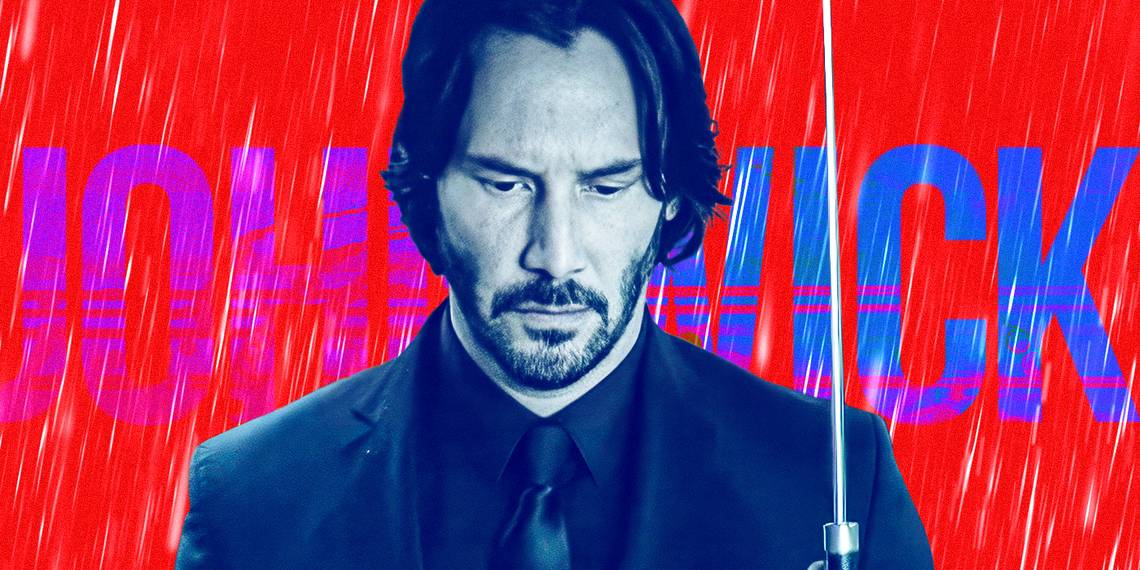“The man, the myth, the legend.”

Image via Jefferson Chacon
THE BIG PICTURE
The knife confrontation in John Wick: Chapter 3 – Parabellum is the best action scene in the series because it showcases all the franchise’s strengths: choreography, cleverness, and humor.
Director Chad Stahelski and the stunt team made the scene as realistic as possible, showcasing how messy knife fights are and putting the gun-fu John Wick at a disadvantage.
The confrontation has more martial arts than other fight scenes, and no music, instead using sound effects to emphasize the fight’s brutality.
The John Wick series is many things at once and one thing never: the latter being, “boring.” Each new entry ups the ante. Those venerated action scenes are spectacles supported by skill, ingenuity, and passion. Declaring one fight scene better than the rest might seem like a fruitless exercise if “above and beyond” wasn’t the goal, and if there weren’t clear contenders.
And, among those contenders, there’s a winner: the knife confrontation in John Wick: Chapter 3 – Parabellum. It doesn’t have the spectacular grandeur of the horse stable or the motorcycle chase, or the visual tricks employed by the hall of mirrors. It doesn’t need it. This seemingly more simplistic (yet anything but) 3-minute brawl has everything that makes John Wick, John Wick: choreography, cleverness, humor, gore, and a protagonist too stubborn to die.

John Wick: Chapter 3 – Parabellum
John Wick is on the run after killing a member of the international assassins’ guild, and with a $14 million price tag on his head, he is the target of hit men and women everywhere.
Release Date: May 15, 2019
Director: Chad Stahelski
Cast: Keanu Reeves , Ian McShane , Jason Mantzoukas , Halle Berry , Anjelica Huston , Laurence Fishburne
Rating: R
Runtime: 143
Main Genre: Action
Genres: Action , Crime
Writers: Derek Kolstad
Tagline: The Grace Period Is Over
Website: https://www.johnwick.movie
The Knife Scene in ‘John Wick: Chapter 3’ Is Realistic

Image via Lionsgate
John Wick: Chapter 3 – Parabellum opens with its titular anti-hero (Keanu Reeves) on the run from a bajillion assassins after breaking the Continental’s rules by killing Santino D’Antonio (Riccardo Scamarcio) in John Wick: Chapter 2. Now labeled excommunicado, John dashes around a rainy New York City nightscape reminiscent of Blade Runner, evading enemies at every turn or killing them with library books.
Early on, he seeks refuge in an antique shop. Bare minutes pass before he’s beset by another group of would-be killers foolish enough to take him on. However, this time around, John’s already tired. He’s injured. He’s weaponless, frantically searching the display guns for an antique that works. He’s not at his usual top of his game. With no advantage except, well, being himself, his opponents quickly corner him. Just as fast, they’re tossing old knives with abandon in between bouts of feisty hand-to-hand combat. In essence, John Wick brought a gun to a knife fight.
This is just one example of how the John Wick movies always take things a step further — and then one more just to see if they can. They layer scenarios like a house of cards, then (to mix metaphors) unpeel the onion to reveal the cocktail of obstacles John must overcome this time around.
The knife scene is no different in its conceit and beats. Director Chad Stahelski and his writing team — Derek Kolstad, Shay Hatten, Chris Collins, and Marc Abrams — decided to ditch the guns and do a “real” knife fight to challenge themselves as much as audience expectations. He told Polygon in 2019:
“In every action movie the hero always throws a knife. And what does it do? It sticks in every time. I know professional knife throwers. That’s where I learned from. Seven out of ten? Miss. […] So we were like, wouldn’t it be nice to do a real knife fight? […] You and your little brother, you have a snowball fight.
How many snowballs can you get in? So we’re gonna have a snowball knife fight where nothing hits. […] We just thought that’d be hilarious. And it’s super serious. No one’s trying to do a gag. But the whole time people are laughing going, oh my god. And I think that’s the secret of a good action sequence.”
Why Is the Knife Fight in ‘John Wick: Chapter 3’ the Best?




Those complimentary attitudes — commitment and humor — make up the knife scene’s bloody heart. At first, the cramped hallway and lack of weapons necessitate a more martial arts-heavy approach than John Wick‘s usual “gun-fu plus” preference.
Without the physical room and therefore the luxury of being snazzy, the choreography is intricately efficient. The performers move with vigorous brutality and mind-melting speed. Remember, kids: experience doesn’t fade with age, it’s enhanced. Scott Adkins, the actor and martial artist who played Killa Harkan in John Wick: Chapter 4, told GQ that he and Reeves improvised their fight when inspiration struck.
“He’s at a level now where he’s so well-trained, we could just come up with all of this on the spot, and he’s able to just do it,” Adkins said. Such skill is intentional on a character level as well: “This is [showing] who [John Wick] was before the first movie,” Chad Stahelski told Polygon, “so let’s get used to it.”
Stahelski and cinematographer Dan Laustsen let that series selling point shine: Reeves’ experience combined with how realistic the stunts are (to a point). The classic John Wick long shots and one-ers dominate, letting viewers’ eyes track the fight.
Even if there’s a flurry of movement, spatial awareness isn’t lost thanks to the performers’ complex actions being clearly, cleanly telegraphed and executed (no pun intended). When the camera moves, it’s to unveil a wider battlefield or emphasize a particular technique, not hide inexperience behind the veil of the infamous shaky cam.
The choreography highlights the tight hallway’s limited maneuverability and uses the camera frame in full; it’s basic cinematic language applied to action, as these things should be. Like all Wick fights, the knife battle has a rhythm, and then different rhythms according to the different sections of a single fight.
Stahelski has often likened film combat to a dance. Appropriately, one of the John Wick hallmarks is timing and speed: people’s motion forcibly paused by a block, or reaction time when a hit is especially painful. Plus, the glass reflections on either side are just visually pleasing.
If we’re talking character-specific hallmarks, then improvisation is one of John Wick’s defining traits. He bends his environment to his advantage every time.
Except this time, his enemies know that trick, too. Introducing the knives is one of the series’ funniest comedy beats, as John and an opponent simultaneously pause, look, realize they’re surrounded by antique knives displayed behind glass cases, and meet each other’s eyes.
Cue both parties shattering said glass and wildly tossing knives. The stunt coordinators incorporate more pizzazz as people slide, duck, and twist like veritable ninjas. But Chad Stahelski’s commitment to realism stays the course: not every thrown blade sinks into its target. In fact, most spin out or harmlessly bounce off body parts thanks to the sheer momentum at work (yay for physics!).
Even if you wouldn’t know knife fight accuracy from Adam, it’s automatically more satisfying to see the world’s best combatants fail before they succeed. (Understandably, but still remarkably, every knife — and every pane of shattered glass — was CGI. “Any time you see a knife being thrown [or someone stabbed], it’s a digital knife,” VFX supervisor Rob Nederhorst explained to Variety.)
The Knife Scene Is Everything That Makes ‘John Wick’ Great

Image via Lionsgate
Hand-in-hand with realism is that pesky party crasher, limited endurance. These people get tired. The longer a conflict continues, the more effort it demands of their bodies (and minds). Not to mention, John Wick’s bullet wound was bleeding enough to stain his shirt before the scene even started.
This refreshing intensity combined with Reeves and the stunt performers’ talent gives everything weight. John and his enemies fight dirty, grabbing everything at their disposal to the point they jerk blades out of their skin to re-use. Bones brutally snap; bodies slam off walls. Even the gore is reserved in comparison to the normal bullet-induced arterial spray — up until John slowly embeds a knife straight into an eye.
Appropriately, the choreography stays elegant but shirks seamlessness. It allows for silliness, too, thanks to this random antique store’s endless knife supply. Cue the increasingly ridiculous use of said knives: one misses John’s crotch, which he promptly snatches up to indignantly throw back.
He piles three to six into one body, which does make sense. Instead of our protagonist’s favorite double tap move with a gun, he uses the first few blades to disarm before landing a killing blow. The fervent “eff you” intensity of his multiple tosses channels the absurdity that almost makes the John Wick movies (very athletically adept) comedies.
As those blades go ham, it’s worth noting the sequence has no music. It’s all ambient sound effects, and brutal ones: knives hissing into flesh and whistling as they cut the air. When John wearily tosses an ax from across the hall into the last survivor’s skull, it makes a resounding auditory thunk and is an emphatic period: this is why John Wick is the Baba Yaga.
It also radiates old man “I’m too tired to walk down there” energy. On opening weekend, I remember my theater gasping, cackling, and applauding our way through this scene.
It’s the best John Wick action scene because it’s a production team on top of their game, one defined by their willingness to reinvent themselves through challenges.
If Keanu Reeves galloping through New York on a horse is Chapter 3 flaunting the franchise’s increasing budget, the knife fight is the chorus line — the synchronized performers a show would fall apart without — taking a well-deserved bow.
News
Reacher Season 3’s Narrowed Release Window Reportedly Revealed
SUMMARY Reacher season 3 could be released in early 2025. Sticking to a yearly release schedule could help Reacher grow its audience. This is especially true since Reacher has consistently high viewership similar to broadcast TV procedural hits. The release window for Reacher season 3 has…
Reacher season 3 premiere date: A tiny new tease
While there may not be a formal Reacher season 3 premiere date yet at Prime Video, there is something more that we can share! Previously, star Alan Ritchson had shared on Instagram that the action drama would not be back until 2025,…
Nicolas Cage Is ‘Terrified’ of AI and Got Digitally Scanned for Spider-Man Noir: ‘I Don’t Want You to Do Anything’ With My Face and Body ‘When I’m Dead’
Nicolas Cage said in an interview for The New Yorker that he is terrified of AI and is hoping recent body scans he had to do for two upcoming projects aren’t used as reference for AI technology to recreate him on screen after…
Reacher season 3 premiere date: The worst-case scenario?
We know that Reacher season 3 is coming at some point to Prime Video. Not only that, but filming is already done! A great deal of the groundwork has already been laid regarding the show’s future, and there is now just a…
Gods Of Egypt’s Casting Controversy Explained
SUMMARY Whitewashing of Egyptian gods with white actors led to a negative impact on Gods of Egypt. Lack of diversity in casting choices resulted in backlash, poor reviews, and financial failure. Movie’s failure at the box office emphasized the importance…
Gerard Butler disses ‘Free Guy’, Ryan Reynolds generously responds
Ryan Reynolds has offered a response to comments from Gerard Butler about his latest feature, ‘Free Guy’, and his other movies. Earlier this month, the ‘300’ star gave an interview to Unilad promoting it, and he included some scathing comments about Ryan Reynolds’ work….
End of content
No more pages to load











